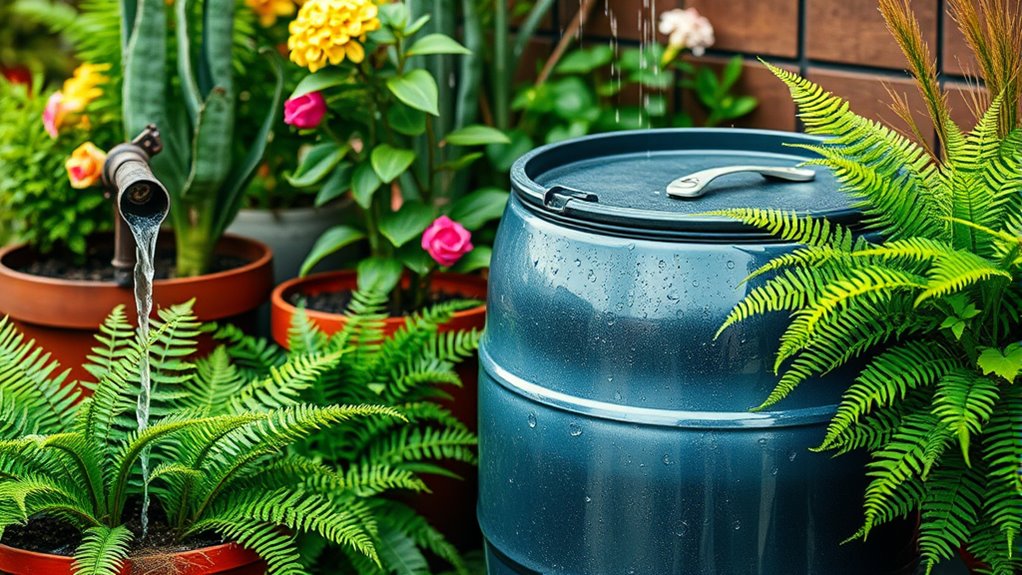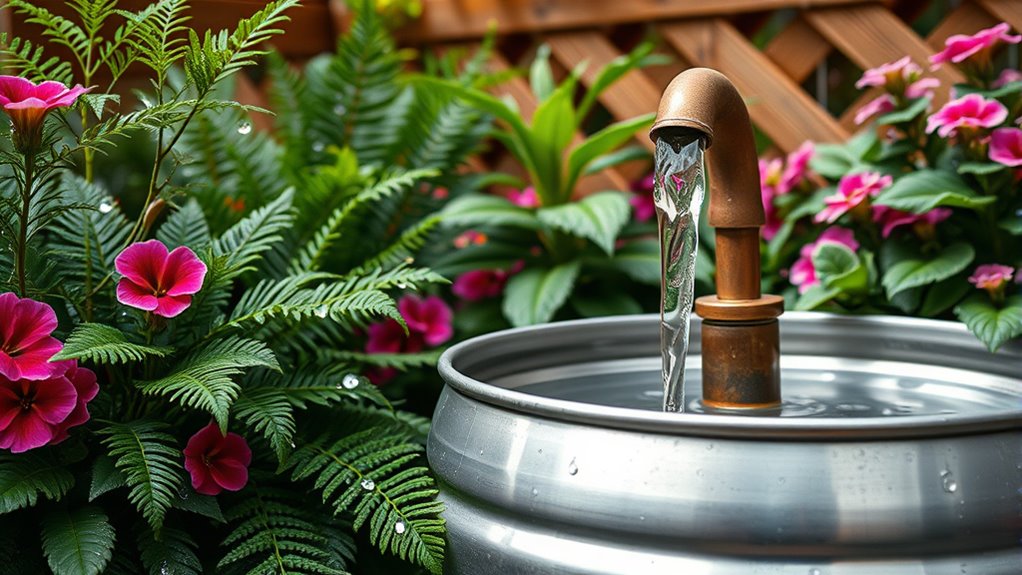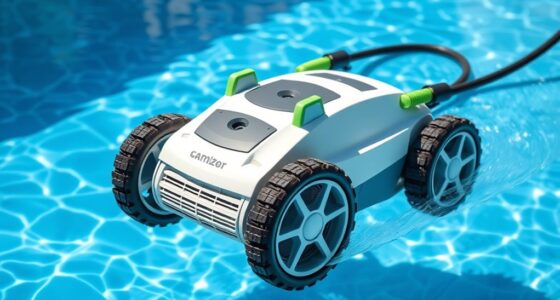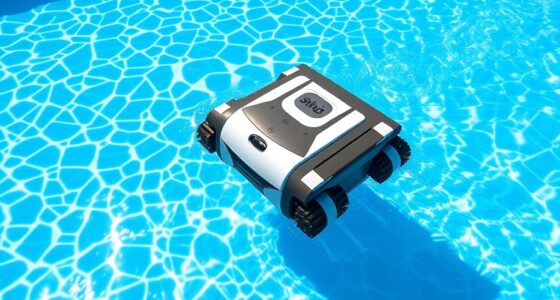Rainwater harvesting is a smart way to supply your patio plants with pure, eco-friendly water. Install rain barrels or tanks under your roof’s downspouts to collect runoff, and cover them to keep debris out. Use gentle watering methods early in the day or late afternoon, ensuring your plants stay moist without overwatering. By taking these steps, you support healthy growth while conserving water—keep exploring to discover more helpful tips.
Key Takeaways
- Install rain barrels or tanks under roof downspouts to collect and store rainwater for patio plant irrigation.
- Use first-flush diverters and lids to keep stored water clean and free from debris and pests.
- Position storage containers on level ground near plants to minimize water loss and facilitate easy access.
- Water patio plants early morning or late afternoon to reduce evaporation and promote healthy growth.
- Regularly clean gutters and filters to maintain water quality and ensure safe, chemical-free watering.

Rainwater harvesting is an excellent way to provide your patio plants with natural, eco-friendly water. By collecting rainwater, you decrease reliance on tap water, which often contains chemicals like chlorine and fluoride that can harm sensitive plants. Plus, using rainwater is a sustainable choice that benefits your garden and the environment. To maximize your setup, it’s important to understand rainwater collection methods. You can install rain barrels or larger storage tanks positioned under your roof’s downspouts. These devices capture rainwater as it flows off your roof, funneling it into containers for later use. Make sure to cover your reservoirs with lids to prevent debris, mosquitoes, and dirt from contaminating the water. You might also consider adding a first-flush diverter, which diverts the initial runoff that may carry roof dust or bird droppings, ensuring cleaner water for your plants. When implementing rainwater collection methods, think about the size and placement of your storage units. Larger tanks hold more water, giving you a steady supply during dry spells, while placing them on level ground near your planting area minimizes water loss from evaporation or spillage. Maintaining your system by regularly cleaning gutters and filters guarantees your water stays pure, helping your patio plants thrive. Proper filtration and storage are crucial to ensure the quality of collected rainwater remains high and safe for your plants.
Once you’ve set up your rainwater harvesting system, focus on your patio plant watering techniques. The key is to keep the soil evenly moist without overwatering, which can lead to root rot or fungal issues. Use a watering can or a garden hose fitted with a gentle spray nozzle to deliver water directly to the base of each plant. This targeted approach conserves water and prevents fungal diseases caused by excess moisture on leaves. Water early in the morning or late in the afternoon to reduce evaporation and allow plants to absorb the moisture effectively. When watering, take note of each plant’s needs; some species prefer consistently moist soil, while others thrive with drier conditions between waterings. Check the top inch of soil regularly—if it feels dry, it’s time to water again. Rainwater is naturally soft and free from salts, making it ideal for most patio plants. Adjust your watering frequency based on weather conditions; during hot, dry spells, you might need to water more often, whereas cooler, humid days require less. Using rainwater also helps maintain the soil’s natural pH balance, promoting healthier roots and better growth. Employing portable rainwater collection systems can make it easier to manage your water supply efficiently and adapt to changing weather patterns.
Frequently Asked Questions
Can Rainwater Harvesting Damage Patio Plants?
You might wonder if rainwater harvesting can harm your patio plants. While it generally benefits them, improper collection or storage can cause issues like plant nutrient depletion or water pH imbalance. If the water becomes contaminated or lacks essential minerals, it could stress your plants. To prevent this, guarantee your system stays clean, and consider testing rainwater periodically, so your plants continue thriving without risks from water quality problems.
How Often Should I Clean My Rainwater Collection System?
You’ve wondered how often to clean your rainwater collection system. The secret lies in a consistent maintenance schedule—usually every 6 to 12 months, but it depends on your environment. Use effective cleaning methods like rinsing filters and scrubbing tanks to prevent debris buildup and algae. Stay vigilant—neglecting these steps could jeopardize your water quality, and you won’t want to discover that too late. Regular cleaning keeps your system reliable and your patio plants thriving.
Is Rainwater Safe for All Types of Patio Plants?
You might wonder if rainwater is safe for all patio plants. Generally, it’s a good option, but chemical contamination from pollution can pose risks. To guarantee safety, check the pH balance, as highly acidic or alkaline water might harm sensitive plants. Using a filtration system can help remove contaminants, making rainwater suitable for most patio plants. Always test your rainwater quality before regular use to protect your plants’ health.
What Are the Best Containers for Storing Rainwater?
You might think all containers are suitable for water storage, but the truth is, container materials matter. Durable options like food-grade plastic, concrete, or metal prevent leaks and contamination. Consider water storage capacity too—you want a container large enough to meet your needs without overloading. Avoid materials that degrade or leach chemicals, ensuring safe, clean rainwater for your patio plants. Proper containers keep your harvest safe and effective for watering.
How Do I Prevent Mosquito Breeding in Rainwater Tanks?
To prevent mosquito breeding in your rainwater tanks, you should regularly inspect and cover the tanks tightly to keep out mosquitoes. Using mosquito-proof screens or mesh over the inlet and outlet helps prevent larvae from entering. Additionally, consider rainwater treatment methods like adding mosquito dunks or tablets, which kill larvae without harming your plants. Routine maintenance and proper tank coverage effectively reduce mosquito breeding and keep your water clean.
Conclusion
By setting up a rainwater harvesting system for your patio plants, you’re investing in their health and your garden’s sustainability. It’s a smart move that pays off in the long run, helping you save resources and nurture lush greenery. Remember, every drop counts—don’t let your efforts go to waste. When you make the most of what nature provides, you’re truly watering your garden’s roots and reaping the benefits.










